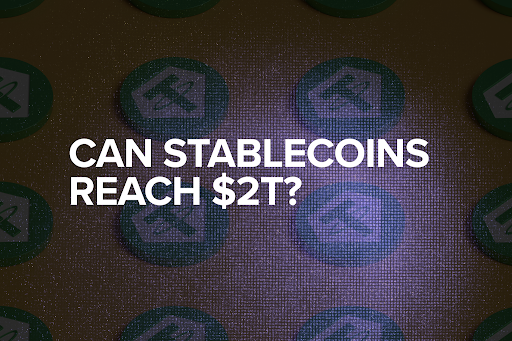Can Stablecoins Really Reach $2 Trillion market cap?

When Treasury Secretary Scott Bessent told a Senate appropriations subcommittee last week that the U.S. stablecoin market could balloon from its current $250 billion to over $2 trillion in just a few years, he painted a picture of digital dollars becoming as commonplace as credit cards. But not everyone is buying the hype.
Just days after Bessent’s bullish prediction, JPMorgan Chase threw cold water on the Treasury’s forecast, warning that stablecoin infrastructure remains “underdeveloped” and growth will likely be far slower than government officials expect.
The clash between Washington’s optimism and Wall Street’s skepticism has set up one of the most consequential debates in modern finance: Can digital dollars really grow eight-fold in the next few years, or are we witnessing another case of regulatory wishful thinking?
Key Takeaways
- Treasury Secretary Scott Bessent predicts the U.S. stablecoin market could grow from $250 billion to over $2 trillion within “a few years”
- JPMorgan Chase challenges this forecast, citing underdeveloped infrastructure and technical limitations
- The recently passed GENIUS Act provides regulatory clarity but doesn’t solve underlying scalability issues
- Current stablecoin usage remains heavily concentrated in crypto trading rather than mainstream payments
- Success depends on solving complex infrastructure challenges around banking integration and cross-border settlements
Treasury’s Case for Explosive Growth
Bessent’s optimistic outlook isn’t emerging from thin air. The Treasury Secretary’s confidence appears rooted in the recent passage of the GENIUS Act, landmark federal legislation that for the first time establishes comprehensive rules for U.S. dollar-pegged stablecoins. The bill, which passed the Senate with bipartisan support in a 68-30 vote, creates a regulated pathway for companies to issue digital dollars with federal oversight.
“The GENIUS Act will protect consumers, enable responsible innovation, and safeguard the dominance of the U.S. dollar,”
Senator Kirsten Gillibrand said in a statement following the bill’s passage.
The legislation addresses many of the regulatory uncertainties that have kept traditional financial institutions on the sidelines. Under the new framework, stablecoin issuers must maintain full reserve backing, undergo monthly audits, and comply with anti-money laundering requirements.
Tether, the world’s largest stablecoin issuer, has already announced plans to capitalize on the new regulatory environment.
CEO Paolo Ardoino recently told Bloomberg Television that the company is “well on its way to establishing a domestic strategy” targeting U.S. institutional clients with a new stablecoin designed specifically for interbank settlements and corporate treasury management.
The efficiency gains from stablecoins in cross-border payments could be a major growth driver.
Traditional international transfers often take days and involve multiple intermediaries charging hefty fees. Stablecoins can settle transactions in minutes at a fraction of the cost, making them attractive for everything from corporate payments to remittances.
JPMorgan’s Infrastructure Reality Check
But JPMorgan sees a different picture. The bank, which recently launched its own deposit token called JPMD for institutional clients, argues that Treasury’s projections ignore fundamental infrastructure limitations that could take years to resolve.
“The stablecoin market forecast of $2 trillion seems overly optimistic given current infrastructure constraints,”
JPMorgan analysts noted in a recent report, pointing to gaps in settlement systems, regulatory compliance frameworks, and technical scalability.
The bank’s skepticism stems from firsthand experience trying to integrate blockchain-based payments with traditional banking infrastructure.
JPMorgan’s JPMD token, built on Coinbase’s Base blockchain, offers features like 24/7 settlement and interest payments but remains limited to institutional clients precisely because of the complexity involved in broader integration.
Technical bottlenecks present significant hurdles. Most blockchain networks still struggle with the transaction volumes required for mainstream adoption. Ethereum, which hosts many major stablecoins, can process roughly 15 transactions per second, which is a fraction of what Visa’s network handles during peak periods.
Banking partnerships add another layer of complexity.
For stablecoins to achieve mainstream adoption, they need seamless integration with existing banking infrastructure, allowing users to easily convert between digital dollars and traditional bank deposits. This requires not just technical integration but also regulatory compliance across multiple jurisdictions.
Market Dynamics Paint a Mixed Picture
Current stablecoin usage patterns suggest the market has room to grow but faces structural limitations. Circle’s USDC and Tether’s USDT dominate the landscape, with most transactions still concentrated in cryptocurrency trading rather than real-world payments.
Recent data shows promising signs of diversification. Cross-border remittances using stablecoins have grown significantly in emerging markets like Latin America, where currency instability makes dollar-pegged digital assets attractive. Companies like Visa have recognized this potential, deploying their payment infrastructure to support stablecoin transactions globally.
However, adoption in developed markets like the United States remains limited. American consumers and businesses already have access to efficient digital payment systems through credit cards, digital wallets, and online banking. The value proposition for stablecoins becomes less clear when existing payment infrastructure already provides instant digital dollar transfers.
WisdomTree, the asset management company, recently launched its USDW stablecoin as part of a “full-stack stablecoin strategy” targeting corporate treasury operations. The move suggests institutional demand exists, but early adoption remains concentrated among forward-thinking companies rather than mainstream businesses.
The International Competition Factor
Treasury’s ambitious projection also reflects geopolitical considerations around maintaining U.S. dollar dominance in the digital age.
“Stablecoins could actually strengthen dollar hegemony by making it easier for people worldwide to hold and transact in dollars”.
– Chiara Munaretto (Stablecoin Insider)
China’s digital yuan and the European Union’s MiCA regulations for digital assets are creating competitive pressure for the United States to establish leadership in digital currency infrastructure. A $2 trillion U.S. stablecoin market would cement America’s position in the global digital finance ecosystem.
But this competition cuts both ways. European stablecoin issuers operating under MiCA could gain advantages in international markets, while central bank digital currencies (CBDCs) from major economies could provide direct competition to private stablecoins.
Infrastructure Investment Requirements
Reaching Treasury’s $2 trillion target would require massive infrastructure investments that industry experts say could take years to materialize.
Payment processors would need to upgrade systems to handle blockchain transactions at scale. Banks would need to develop custody solutions for digital assets. Regulatory agencies would need to build oversight capabilities for a market eight times larger than today’s.
The GENIUS Act provides regulatory clarity but doesn’t solve these practical challenges. State-level compliance variations add complexity, as issuers with less than $10 billion in outstanding stablecoins can choose between federal and state regulation, creating a patchwork of requirements.
Polymarket, the prediction market platform, recently announced plans for its own stablecoin that could “revolutionize payroll solutions” for startups and freelancers. While innovative, such use cases remain niche compared to the mainstream adoption required for trillion-dollar market growth.
Expert Assessment: Realistic vs. Optimistic
Academic economists who study financial technology adoption patterns suggest Treasury’s timeline may be aggressive. Historical precedents for payment system transformation from checks to credit cards to digital payments typically unfold over decades rather than years.
“Payment system changes require not just technology but behavioral shifts, regulatory adaptation, and infrastructure coordination across thousands of institutions. The Treasury’s projection assumes all these pieces fall into place simultaneously.“
explains Dr. Sarah Chen, a financial technology researcher at MIT.
Industry insiders offer more nuanced views. Representatives from major stablecoin issuers acknowledge infrastructure challenges while pointing to accelerating institutional interest. Traditional finance executives remain cautious, viewing stablecoins as complementary to rather than replacements for existing payment systems.
The Verdict: Possible but Problematic
Treasury’s $2 trillion prediction isn’t impossible, but achieving it would require solving complex coordination problems across technology, regulation, and market adoption. The GENIUS Act creates necessary regulatory foundations, but infrastructure development, banking integration, and mainstream adoption present significant hurdles.
JPMorgan’s skepticism reflects real-world implementation challenges that government projections may underestimate. However, the bank’s own investment in deposit tokens suggests even skeptics see long-term potential in blockchain-based payments.
The most likely scenario falls between Treasury’s optimism and JPMorgan’s caution.
Stablecoin growth will probably continue accelerating, driven by specific use cases like cross-border payments and institutional treasury management, but reaching $2 trillion may take longer than “a few years.”
Key indicators to watch include major bank partnerships with stablecoin issuers, successful integration of blockchain payments with traditional banking infrastructure, and adoption rates among mainstream businesses rather than crypto-native companies.
What’s certain is that this debate reflects broader questions about the future of money itself. Whether stablecoins reach $2 trillion in two years or ten, their growth trajectory will reshape how we think about payments, monetary policy, and financial sovereignty in the digital age.

